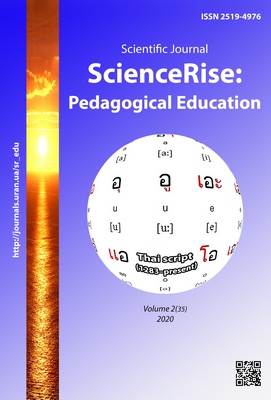Modern peculiarities of lectures in clinic discipline for english-speaking students
DOI:
https://doi.org/10.15587/2519-4984.2020.199114Keywords:
multimedia lecture, questionnaire, students, English-speaking training, quality of teaching, Pediatric PropaedeuticsAbstract
The aim of the study is the improvement of the modern lecture content in clinical discipline Pediatric Propaedeutics for the foreign students with English language of study. Bibliographic, descriptive methods are used in the research, students are anonymously questioned; processing of the obtained results is carried out by methods of mathematical statistics. Based on our own experience in teaching the discipline Pediatric Propaedeutics, we have created the lecture content for the English-speaking foreign students at the department. Well-structured, well-prepared multimedia lectures with a well-established audience feedback mechanism and extensive use of illustrative materials is in the base of this content. According to the standpoint about a student-centered teaching, the students' opinion of the quality of lectures and ways to improve them is a subject to careful study. According to the questionnaire, among 185 surveyed students, 84.9% rate the quality of lectures on a five-point scale as "5" or "4", 13.5% rate it as "3". 90.8% of the respondents name the lectures as interesting and useful, but 27.6% of the surveyed students say that they do not consider the lectures to be a necessary form of study. The most frequently interviewed students make suggestions to increase the amount of illustrative material, to give an opportunity to use lectures during independent preparation and to allow free attendance of lectures. Considering the previous positive experience of placing a text-based version of lectures on the site of the department, posting on the site a full package of multimedia lectures may be useful. Lectures are a well-studied methodical form of classes, but the issues of the organization of lectures remain relevant. The results of the questionnaire of students about the quality of lecture at the department indicate a positive assessment of the majority of respondents. Ways to improve the lecture content are careful methodological and technical support of lectures, the use of innovative technologies. It is advisable to place multimedia lectures on the site of the department for independent work of students
References
- Ilchenko, S. I., Yaroshevskaya, T. V., Skryabina, E. V., Kramarenko, N. N. (2018). Analysis of the level of knowledge of pediatric propaedeutics, taught in junior courses among young doctors. ScienceRise: Pedagogical Education, 7 (27), 28–32. doi: http://doi.org/10.15587/2519-4984.2018.153376
- Maksymenko, S. D., Filonenko, M. M. (2014). Pedahohika vyshchoi medychnoi osvity. Kyiv: Tsentr uchbovoi literatury, 288.
- Fitsula, M. M. (2014). Pedahohika vyshchoi shkoly. Kyiv: Akadem. vydav., 456.
- Lau, K. H. V., Fallar, R., Friedman, E. (2015). Characterizing the Effective Modern Medical School Lecture. Medical Science Educator, 25 (2), 107–112. doi: http://doi.org/10.1007/s40670-015-0102-1
- Chao, S. H., Brett, B., Wiecha, J. M., Norton, L. E., Levine, S. A. (2012). Use of an Online Curriculum to Teach Delirium to Fourth-Year Medical Students: A Comparison with Lecture Format. Journal of the American Geriatrics Society, 60 (7), 1328–1332. doi: http://doi.org/10.1111/j.1532-5415.2012.04035.x
- Billings-Gagliardi, S., Mazor, K. M. (2007). Student Decisions about Lecture Attendance: Do Electronic Course Materials Matter? Academic Medicine, 82, 73–76. doi: http://doi.org/10.1097/acm.0b013e31813e651e
- Wood, W. B., Tanner, K. D. (2012). The Role of the Lecturer as Tutor: Doing What Effective Tutors Do in a Large Lecture Class. CBE – Life Sciences Education, 11 (1), 3–9. doi: http://doi.org/10.1187/cbe.11-12-0110
- Bakhrushyn, V. (2018). Universytet i student. Available at: http://education-ua.org/ua/articles/1270-universitet-i-student
- Kramar, S. B., Nasarova, D. I., Zharikov, M. Yu. et. al. (2015). Role of lecture in the modern education system. European Applied Sciences, 4, 22–24.
- Lutze-Mann, L., Kumar, R. K. (2013). The formative assessment lecture: enhancing student engagement. Medical Education, 47 (5), 526–527. doi: http://doi.org/10.1111/medu.12162
- Krytska, H. A., Krytskyi, I. O., Zahrychuk, H. Ya., Krytskyi, T. I. (2017). Prospects and difficulties of the effective innovative technologies use for providing medical students professional training during clinical disciplines study. Medical Education, 2 (74), 33–36. doi: http://doi.org/10.11603/me.2414-5998.2017.2.7826
- Hai, L. A., Sukhin, Yu. V., Venher, V. F., Saied Muksen, Serdiuk, V. V. (2016). Suchasni metody vykladannia medychnykh dystsyplin u vyshchii shkoli. Medychna osvita, 1, 16–20.
- Labii, Y. A. (2018). The improvement of lecturing material methods for foreign students. Medical Education, 1, 18–21. doi: http://doi.org/10.11603/me.2414-5998.2019.1.9574
- Iaremenko, O. B., Fedkov, D. L., Dobrianskyi, D. V., Dudka, P. F., Ilnytskyi, R. I., Tarchenko, I. P., Meliksetyan, A. V. (2018). Changing the format of lecture classes for new generation medical students. Medical Education, 4, 117–120. doi: http://doi.org/10.11603/me.2414-5998.2018.4.8850
Downloads
Published
How to Cite
Issue
Section
License
Copyright (c) 2020 Tatyana Yaroshevskaya

This work is licensed under a Creative Commons Attribution 4.0 International License.
Our journal abides by the Creative Commons CC BY copyright rights and permissions for open access journals.
Authors, who are published in this journal, agree to the following conditions:
1. The authors reserve the right to authorship of the work and pass the first publication right of this work to the journal under the terms of a Creative Commons CC BY, which allows others to freely distribute the published research with the obligatory reference to the authors of the original work and the first publication of the work in this journal.
2. The authors have the right to conclude separate supplement agreements that relate to non-exclusive work distribution in the form in which it has been published by the journal (for example, to upload the work to the online storage of the journal or publish it as part of a monograph), provided that the reference to the first publication of the work in this journal is included.








